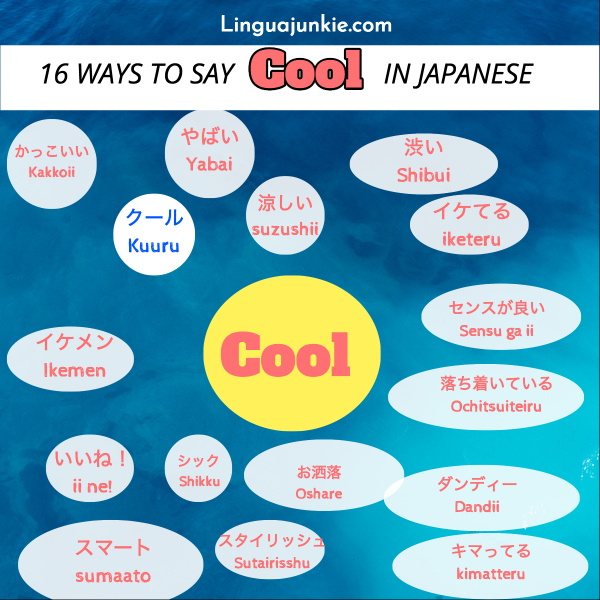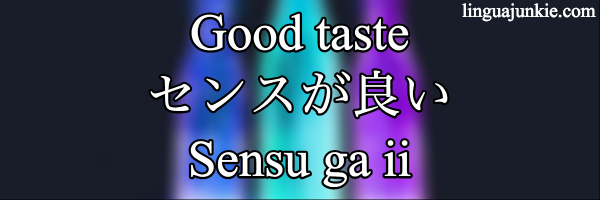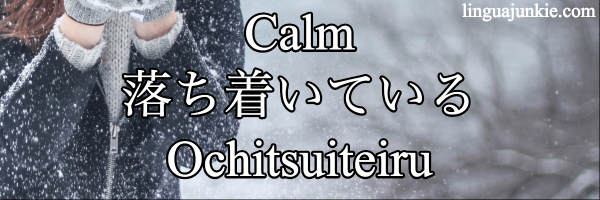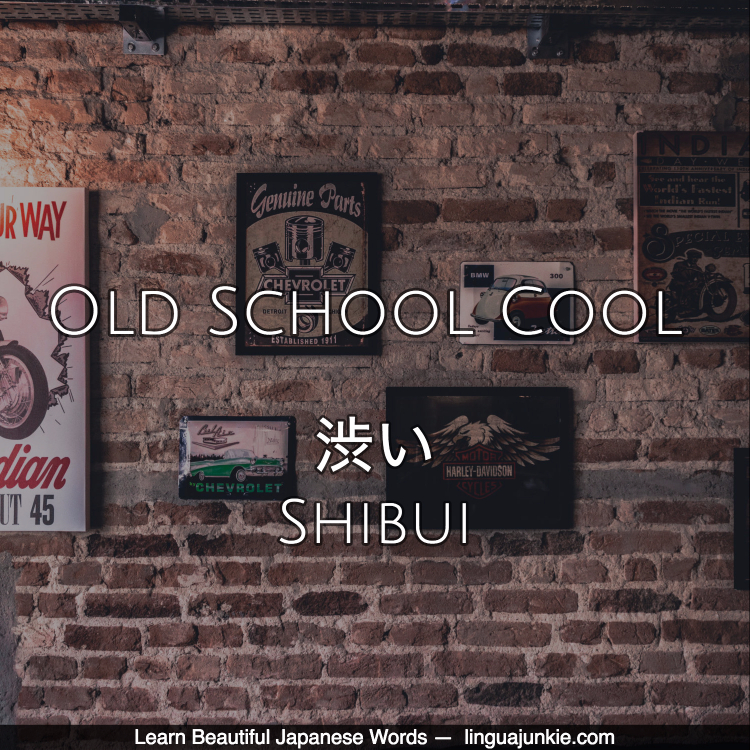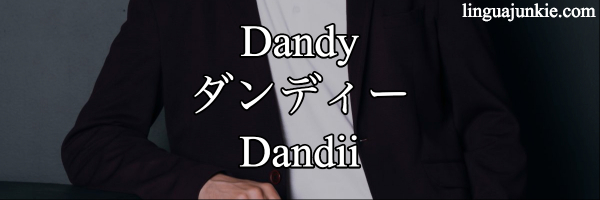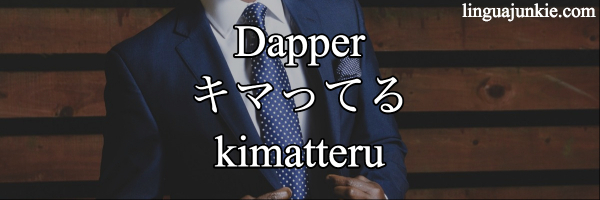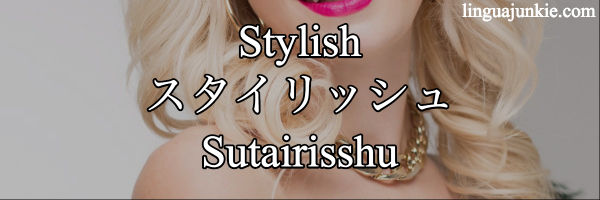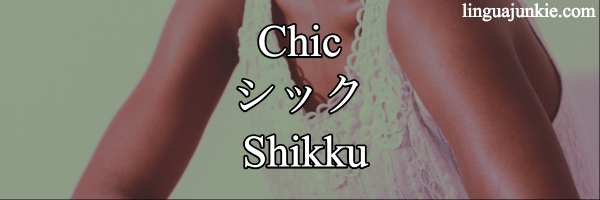What’s かっこいい (Kakkoii)?
Calling someone… Ugly/Uncool/Not Cool?
Sentence Examples
When NOT to use かっこいい (Kakkoii)
What’s かっこいい (Kakkoii) in Japanese?
Ever walked across the street and noticed a person or thing that almost made you turn head over heels? In English, you’d say “Oh my God, that’s so cool!”. But how about in Japanese? What would YOU say? Well, today we shall cover just that through using the Japanese word かっこいい (Kakkoii)!
The word in itself is comprised of 2 parts:
1. 格好(かっこう)- Read as Kakkou
2. いい – Read as Ii
The former refers to the “Appearance” of someone or something whereas the latter is an adjective used to describe something as “Good”. When put together, these 2 words form Kakkoii, of which would be used to describe someone or something as “Good Looking” or “Cool”. Do note that this is mostly used to describe something or someone with a known physical presence rather than a situation. 😇
For example, you’d go like “That Guy/Car over there is Kakkoii” but not “You’re up for Karaoke later? Kakkoii”. We’ll touch more on this in a later section.
Calling someone… Ugly/Uncool/Not Cool?
So… What would be the antonym for the word かっこいい (Kakkoii) then?
Well, it can be either of the following 2:
1. かっこよくない – Read as Kakkoyokunai
2. かっこ悪い(かっこわるい)- Read as Kakkowarui
As mentioned earlier, the word かっこいい (Kakkoii) itself is a combination of two words, namely “Kakkou” and “Ii”. Therefore, to express the opposite of Kakkoii, we would have to conjugate the word “Ii” into “Yokunai”. Thereby, leaving us with Kakkoyokunai which basically means “Not Handsome/Cool”.
If you’d like to sound more crude and brutal, then the latter would be your best bet. “Warui” is often used to describe something as bad or distasteful. By putting it together with “Kakko”, we’d get the word “Kakkowarui” which is used to describe someone’s appearance as ugly.😈
Sentence Examples
After all that babbling on the meaning of the Kakkoii and its Antonyms, let’s now take a look at how to go about using the word itself in a conversational context. Below are a few scenarios in which the word “Kakkoii” would be deemed appropriate for use:
1. When you see Someone/Something which sparks your interest.
あの人/あの車、かっこいいね!
Romaji: Ano hito/Ano kuruma、Kakkoii ne!
English: That person/that car over there looks cool, doesn’t it!
2. When you’d like to bring the attention of others to something you own.
ねえ、私の車、かっこいいでしょ?
Romaji: Nee, Watashi no Kuruma, Kakkoii desho?
English: Hey, do you think my car looks cool?
3. When you’d like to describe the appearance of something in general.
お、そのスーツかっこいいね、どうしたの?!
Romaji: Oh, sono suutsu kakkoii ne!
English: What’s up with you and that cool suit?
When NOT to use かっこいい (Kakkoii)
As we know, かっこいい (Kakkoii) is mostly used to describe something or someone with a known physical presence rather than a situation.
Therefore, the following scenario is in which when the use of かっこいい (Kakkoii) would be deemed INAPPROPRIATE:
Japanese:
Person A: 後でカラオケはどう?
Person B: いいよ!
Person A: かっこいい!
Romaji:
Person A: Ato de Karaoke wa dou?
Person B: Ii yo!
Person A: Kakkoii!
English:
Person A: How about Karaoke after this?
Person B: Sure!
Person A: Handsome/Cool!
Note: In this case, we would instead reply with a “いいね!” as opposed to a “かっこいい!” if we’d like to say something along the lines of “Cool!”.
In an English Conversation, using the word “Cool” may seem very common to express your satisfaction with a situation. But remember, かっこいい (Kakkoii) is used to describe the Physical Appearance of something and not a Situation. With these in mind, we hope you have a better understanding of the word and can start moving towards mastering your Japanese Language!💪
Click to tweet this article and share it with others!
Learn more Japanese phrases like Kakkoii by studying Japanese with us. Find out more by filling out the form below. Courses can be found here.
Would you like to study Japanese in Japan?
Realize your dream of moving to Japan and becoming fluent in Japanese.
Move to Japan
Hey Junkies!
Do you want to know ALL the ways to say Cool in Japanese?
Here’s a list of phrases that you can use in all kinds of situations. Some are the literal cool. Others are weather “cool.” And the rest deal with “cool looks.” You’ll learn them all.
Don’t forget to:
- Read these out loud and practice
- Print this out for reference
- Try to use them in actual conversations
- Check out the Japanese learning program below
Now, let’s start with our “cool” phrases!
Simple and easy!
- Kakkoii
- Meaning: cool (good looking or a generally cool/impressive person)
The closest and most direct translation of “cool” in English, is the word “かっこいい”. Usually, you can use this to relate to someone or something that you find as “cool” or “smart and good looking.” Outside of looks, you can also use this word to describe people you think are cool, like athletes, artists, and anyone with some impressive talent or skill.
A more slangy variation of this is:
- かっけー
- kakkee
2. Crazy やばい
- Yabai
- Meaning: Crazy, very. Can be used to intensify verbs and adjectives.
This is one of the best ways to say cool in Japanese. Literally it means “Crazy,” but it can mean crazy good and crazy bad or “That’s crazy!”
“Yabai” can also be an intensifier for adjectives or verbs in a good or bad way as well. Kind of like you can say “crazy/really hungry” or “really cool.”
3. Nice いいね
- ii ne
- Meaning: Nice, that’s cool, I like that.
This is another useful word you can use when you just want to casually agree to something, or give your subtle nod of approval like “That’s cool.” In fact, “ii ne” is the Japanese version of the social media “thumbs up/like.”
4. Cool クール
- Kuuru
- Meaning: cool (Borrowed from English)
You can use this word about someone you think is “calm and collected”. Someone you think that exudes coolness by not showing much emotion. Think James Dean type of cool.
5. Cool 涼しい
- suzushii
- Meaning: cool (weather-wise)
Want another way to say cool in Japanese? How about “cool” weather? If you want to talk about how chilly it is outside, use “suzushii.” This one of the more common Japanese weather words to know.
6. Good taste センスが良い
- Sensu ga ii
- Meaning: “sense” is good
“センス” comes from the English word “Sense”, but don’t mistake it from the actual meaning in English. In Japanese, it is equivalent to the word “Taste”. You can use “センスが良い” in many different scenarios. You can tell someone they are fashionable, or that have good taste in food, art, and the likes. If a friend chooses the next place for your get together, you can tell them “センス良いね (sensu ii ne)”.
7. Calm 落ち着いている
- Ochitsuiteiru
- Meaning: Calm, collected
You can use this phrase to tell someone that they are mature and cool. Often times, coolness in English is associated with calm, collected, and someone who shows very little emotion. This is no different in Japanese.
8. Classic (old school cool) 渋い
- Shibui
- Meaning: Bitter (literal)
The literal translation is “bitter” or “plain”. It may seem very off from cool, but “渋い” is often associated with the taste of coffee, or expressing someone who has wisdom with a certain class to them. You can use this to express someone who is cool and calm.
9. Attractive イケてる
- iketeru
This is close to the word “イケメン”. The first part of the word “イケ” comes from the word “いかしてる (ikashiteru)” to mean “cool” or “attractive”.
10. Cool/Handsome イケメン
- Ikemen
- Meaning: good looking guy/handsome/cool
Cool is also associated to looks and overall attractiveness in Japanese just like in English.
So, you can use “イケメン” if you think a particular male is good-looking or handsome. This isn’t used for women, but you can use the word “美人” to say that a female is good-looking or beautiful.
11. Dandy ダンディー
- Dandii
- Meaning: fashionable (for older guys)
This is a term usually used for middle aged men who you think dress in a mature classic way.
12. Dapper キマってる
- キマってる
- kimatteru
This is a slang that comes from the word “決める” which means “to make a decision”. However, a mixture of katakana and hiragana is used to distinguish it from the original word and its meaning.
If a friend, particularly a male friend, comes to a party well-dressed, or if you think that they’ve put some thought and effort in their appearance, you can tell them “キマってる!”
13. Fashionable お洒落
- Oshare
- Meaning: stylish/fashionable.
You can use this phrase to anyone you think is fashionable. You may also see it around in katakana written as “オシャレ”. This is usually used for women.
14. Stylish スタイリッシュ
- Sutairisshu
- Meaning: same as English – stylish
Another way to compliment someone’s taste in clothing is calling them “スタイリッシュ”. You can use it in the same way you use “おしゃれ”.
15. Smart-looking スマート
- sumaato
- Meaning: Looks good/slim/well-dressed.
This word often comes from the English word “smart.” But you can use it to refer to the physical attractiveness of a person. In mainstream Japanese media, “スマート” is often used to describe a man who looks good in well-fitted business suit.
Or, someone who seems intellectual judging by the way they look. Fun fact: Sometimes, Japanese people use “スマート” to mean “slim, too.
16. Chic シック
- Shikku
- Meaning: chic in a fashionabls/sophisticated way
Just like the English word “Chic” pronounced as “sheek”, you can use this to refer to someone stylish and fashionable, often used for women that dress in a professional or sophisticated way. Next time you meet a girl and want to compliment their outfit, give them a quick comment like “今日、シックだね (Kyou, shikku dane)”.
Conclusion: How to Say Cool in Japanese.
Now you know all the cool ways to say cool in Japanese.
They are all quite simple and easy to use.
All you’ve got to do is sneak them in in your Japanese conversations!
Want to learn even more words and learn Japanese? Check out my other posts:
- Japanese MP3 Lessons
- How To Introduce Yourself in Japanese
Or, stop reading articles and check my recommended Japanese learning program below.
Good luck Junkies!
– The Main Junkie
P.S. Want to learn & speak the Japanese language?
Check out JapanesePod101, a complete Japanese learning program with audio and video lessons, apps, study tools and PDF lesson notes. I think their lessons can and will help you learn and speak Japanese to a certain level.
Click here to visit JapanesePod101.com & speak Japanese with fast + easy lessons
These examples may contain rude words based on your search.
These examples may contain colloquial words based on your search.
とてもクール
カッコイイ
カッコいい
クールだ
とても涼しい
とってもクール
とっても素敵
ようにクールな
かっこいい
ので、涼しい
カッコよかっ
本当にクール
すごい
so cool
かっこ
Suggestions
The story was so cool and visually this video is picture-perfect for 120 minutes straight.
物語はとてもクールだったし、視覚的にこのビデオは絵に描いたようなためであります 120 ストレート分.
But can be triangular loop play, it so cool the.
しかし、三角形のループを再生することができるとてもクール。
The special rewards are all so cool!
特別報酬のアイテムはどれもカッコイイものばかりです。
Woliang riding too fast, not so cool for a long time, and are difficult road suppressed.
Woliang乗馬が速すぎるので、長い時間のためであり、困難な道にクールさを抑制した。
Light foot on the sand so cool, warm.
New insights and issues are so cool and fun.
He’s so cool that we all think he’s charismatic.
彼ってクールだから、私たちみんな彼にはカリスマ性があると思っている。
When I was a child, Japan seemed so cool.
What is so cool in the EA version?
EA のバージョンでとても涼しい何ですがあります?
Christmas in Shanghai… that’s so cool!
上海のクリスマスかぁ なんか素敵そう
It’s so cool you get the mist on the side…
それがまたすげえ冷たくて霧もこっち側へ…
This thing was so cool at the age of 10.
It was less than 100 money, and eat so cool.
100お金よりも小さいとされたので、涼しいを食べる。
The view is a river view, look so cool and bright.
抜けた川眺望と窓が多いことから明るいお部…
It is so cool to see the kids connect with animals up close.
子供たちが近くに動物と接するのを見るのはとても涼しいです。
Wave layers of waves, struck me feel so cool.
波の波層、私は涼しく感じる三振。
It looked so cool looking from the other side of the platform.
Look into to the air-conditioned room is really so cool.
空気にに見て、ルームエアコン本当にクールです。
If it is summer, be sure to wash the mud bath is so cool.
もし夏には、泥風呂を洗うように涼しくなっていることがあります。
Suggestions that contain so cool
Results: 331. Exact: 331. Elapsed time: 110 ms.
Team Japanese uses affiliate links. That means that if you purchase something through a link on this site, we may earn a commission (at no extra cost to you).
‘Cool’ is a very flexible word in the English language. It can be used to describe someone’s fashion sense, action movie stunts, or a gift you received from a friend.
It’s also used as a response in agreement to something or someone: ‘Let’s head to the amusement park.’ ‘Cool!’
The most popular Japanese word for cool is kakkoii (カッコイイ / かっこいい), and it can also be used in nearly the same manner as in English. But did you know that there’s a variety of ways to say cool in Japanese? There are words for ‘cool guy’, ‘cool taste (in fashion)’ and a lot more.
- Kakkoii
- Ii yo / ii ne
- Yabai
- Sugoi
- Saikou
- Subarashii
- Oshare
- Sensu ga ii
- Shibui
- Ikemen
- Yatta
- Manji
かっこいい
Cool
Kakkoii (格好いい / カッコイイ / かっこいい) is the most common Japanese word for cool. It also means ‘good looking’, ‘handsome’, and ‘stylish’. Typically, it is used to describe the fashion style of a person, or the appearance of a person or object.
You wouldn’t use kakkoii for abstract ideas; in this case, it is better to say ii ne (いいね) or one of the other phrases discussed later on.
The word kakkoii comes from the words kakkou (格好 / かっこう) meaning ‘appearance’, and ii (良い / いい) which means ‘good’. Nowadays, however, it is usually written in hiragana or katakana, or a mixture of both:
- かっこいい
- カッコイイ
- カッコいい
Pretty sure most anime fans have heard this word in an episode or two before. Sometimes, users of the word prefer the slang version kakkee (かっけー). In Haikyuu!!, the character Hinata uses kakkee a lot to compliment their libero, Nishinoya, when he uses his move called ‘Rolling Thunder’.
To say ‘very cool’ in casual Japanese, you can say meccha kakkoii (めっちゃかっこいい). The word meccha means ‘very’ or ‘extremely’. Similarly, totemo kakkoii (とてもかっこいい) is a more polite way to say ‘very cool’!
When used to describe a person’s appearance, kakkoii can mean ‘handsome’ or ‘attractive’. It is basically just used for boys/men. If you want to compliment a girl’s appearance, it’s safer to say kawaii or one of these other Japanese words for beautiful. However, you can use kakkoii for a girl to describe her cool behaviour or skills.
Ii yo / ii ne
いいよ / いいね
That’s cool
When casually conversing with your Japanese friends and you want to agree with what someone is saying, ii yo (いいよ) or ii ne (いいね) is appropriate. It means ‘okay’, ‘sure’, ‘no problem’, or ‘I’m cool with it’. Note that this informal way of saying okay is not suitable for a business setting.
This comes from the word yoi (良い / よい) and is conjugated as an i-adjective. Adding yo (よ) or ne (ね) adds emphasis to your agreement and can convey enthusiasm.
Yabai
ヤバイ
Crazy
Sometimes, yabai (ヤバイ / やばい) can be associated with a negative outcome because of its original meaning of ‘dangerous’. In this case, yabai can also mean ‘terrific’, ‘awesome’, or ‘crazy’ in a good way.
It can be difficult to determine if yabai is used positively or negatively, but the key is to understand the context of the situation.
Sugoi
すごい
Awesome
Sugoi (すごい) is one way to say ‘awesome’ or ‘incredible’ in Japanese. This word is typically used in two ways: as an exclamation to convey amazement, and as an adverb meaning ‘really’ or ‘very’.
As a standalone expression, sugoi is used when you see someone doing an impressive action or when you see something amazing. A stunning view of Mt. Fuji? Sugoi! Your friend shows off their crazy hidden dance skills? Sugoi!
As an adverb, sugoi or sugoku (凄く / すごく) is used to intensify the positive or negative traits of something. For example, sugoi ame can mean ‘awful rain’, while sugoi hanabi can mean ‘amazing fireworks’.
There are many cool ways to use sugoi (no pun intended) and this article by Alex Rockin Japanese explains them very well!
The more masculine and slangy form is sugee (スゲー).
Saikou
最高
The best
The word saikou (最高 / さいこう) is a way to say ‘best’, ‘wonderful’, or ‘great’. It can be used to describe a person, object, or experience.
Saikou is made up of the following kanji with their onyomi readings: sai (最 / サイ) for ‘utmost’ and kou (高 / コウ) for ‘high’.
Subarashii
素晴らしい
Wonderful
Another way to say cool in Japanese in an abstract way is subarashii (素晴らしい / すばらしい). It means ‘wonderful’, ‘splendid’, or ‘magnificent’. It is used in the same manner as the rest of the adjectives listed previously, and it can be a great compliment for someone!
You can say subarashii yakiniku to compliment the cook, or say subarashii when your friend flawlessly plays the violin, etc.
Oshare
お洒落
Stylish
Now this word is more specific to cool fashion styles. Oshare (お洒落 / おしゃれ) is frequently seen in fashion magazines, stores, or social media posts. It means ‘stylish’ or ‘fashionable’ and is also spelled out in katakana (オシャレ).
When describing a smartly-dressed person, you can refer to them as oshare-san (お洒落さん / おしゃれさん). You can find many oshare-san in fashion and shopping districts like Harajuku, Shinjuku, or Shibuya.
Sensu ga ii
センスがいい
Cool taste
Sensu ga ii (センスがいい) is a way to say ‘you have good taste in ___’! Sensu refers to one’s sense in fashion, music, or even humor. Ii (いい) as said earlier, means ‘good’.
This phrase is a great compliment for anyone. That way, you are letting them know that you find their interests and style cool.
Shibui
渋い
Old-school cool
The word shibui (渋い / しぶい) originally means ‘elegant and unobtrusive’, and refers to a certain aesthetic that is simple and classic, yet exudes a calm elegance. Think coffee shops, retro-style fashion and accessories.
Its dictionary meaning is ‘bitter’ or ‘harsh’, but young people now use shibui as a way to describe the ‘old-school cool’ aesthetic. A person’s voice or face can also be called shibui (ex. shibui koe) – with a positive connotation like being dandy or the mature type of ‘cool’.
Ikemen
イケメン
Cool guy
Ikemen (イケメン) means ‘cool guy’ or ‘handsome man’. They usually have an attractive hairstyle, face, or personality, manly and built physique – the ultimate heartthrob!
Anime, manga, and video games always have at least one character that falls into the category of ikemen. Japanese idols and actors are also called ikemen, and many polls are held to find out fan favorites.
The word originates from iketeru (イケてる) which means ‘cool’ or ‘stylish’, and men (面 / メン) meaning ‘face’. It is typically written in katakana.
Yatta
やった
Woohoo!
The expression yatta (やった) is a word for ‘cool’ made for jump-for-joy situations! Yatta is the Japanese equivalent of ‘woohoo!’ or ‘hooray!’.
This expresses happiness about a good result, like a good grade, winning a contest, achieving a goal, and more.
Manji
卍
Wow!
Maji manji (マジまんじ / マジ卍) was popularized as an internet slang by young Japanese high schoolers back in 2016-2017. It means ‘cool’, ‘wow’ or ‘awesome’ and generally expresses excitement or approval. Manji already existed as a standalone expression, but the addition of maji was only recent.
Since trends get old quickly, you might sound strange trying to use manji on the internet nowadays, but let’s get to know the background of the kanji.
The swastika symbol is controversial in the West because of how it was used by the Nazis during World War II, but when it comes to Buddhism, it is a positive symbol! It means ‘luck’ and ‘peace’ and is used on maps to mark the location of Buddhist temples.
Words for cool in Japanese
As you can see, there are heaps of words for cool, awesome, great in Japanese!
Want to be one of the cool kids and learn how to speak Japanese? We recommend JapanesePod101. Sign up for free and start learning real Japanese, as it’s spoken today.
Related posts:
- 9+ Stunning Japanese Words For ‘Beautiful’
- 18 Badass Japanese Slang Words to Impress Your Friends
- 17 Japanese Anime Words All Fans Must Know
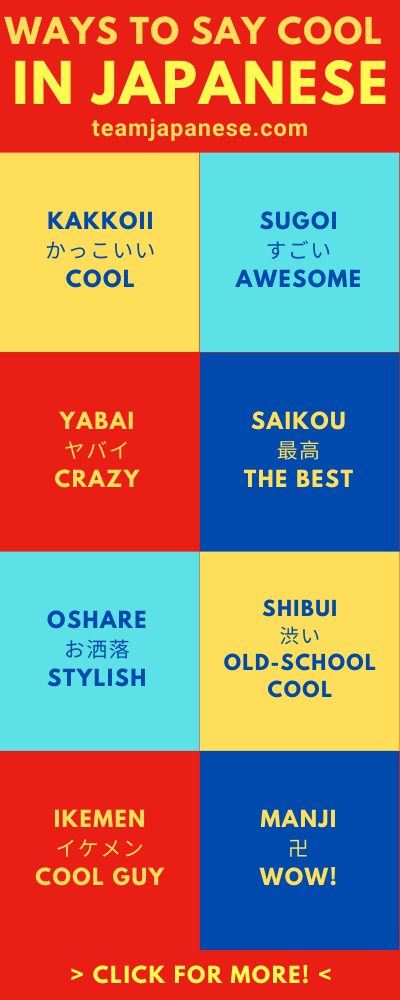

Thea Ongchua
Thea is a freelance content writer, currently majoring in Japanese studies. She likes to create art and draws inspiration from film and music. Thea was inspired to study Japanese language and culture by reading the literary works of Haruki Murakami and Edogawa Ranpo.
How do you say cool in Japanese? Well today’s your lucky day because that’s what I’m going to be covering in this article.
The first thing we’ll have to distinguish is between the different English meanings. Here’s a couple of them now that I’ll be going over in the below post:
- at a low temperature
- showing no friendliness
- remaining calm
- fashionably attractive
Read on to learn each one and see the different ways they can be used.
1. Cool = at a low temperature
The first word that we’ll go over is the one that you would use when talking about the weather or when you’re describing the temperature in a room.
The Japanese word is 涼しい (suzushii) and not only does it mean “cool” but it also brings with it the meaning of “refreshing.”
So, you step outside to see how it feels and it’s that perfect temperature where you could put on a light jacket if you wanted to, but you could also go out in just your T-shirt.
- 涼しい風が吹いている。
- suzushii kaze ga fuite iru.
- The cool wind is blowing.
Another thing to keep in mind about the word cool when it comes to temperature is that it can also be used to describe an action, like when you are cooling something down.
So for example, let’s say that you got home from the store and you bought some sake (Japanese rice wine) which was being stored at room temperature.
You like to drink it chilled, so you put it in the fridge to cool it down. The word to use in this situation is 冷やす (hiyasu).
- 酒を冷やす
- sake o hiyasu
- cool the sake
2. Cool = showing no friendliness
Another way that cool can be used is when describing someone’s attitude, behavior, or their personality.
Having said that, it’s probably more common to hear them described as being cold in English, rather than cool. Nevertheless, there is a Japanese word that has this same meaning which would be a good one to learn.
The word is 冷淡 (reitan) and as you can see from the way that it’s spelled, it shares a kanji with 冷やす which we covered a moment ago in the first section.
The Japanese definition of 冷淡 is:
- 関心や興味を示さないこと。
- kanshin ya kyoumi o shimesanai koto.
- Showing no interest or concern.
In other words, it’s apathy.
So let’s say that there’s a person you’re interested in at a party so you go over to talk to them and introduce yourself, but after a while it becomes apparent that they’re not into you at all.
They say something like, “could you just go away?” and you’re standing there thinking that there’s no need to be so rude!
- そんな冷淡なことを言わないで。
- sonna reitanna koto o iwanaide.
- Please don’t say such cold (unkind) things.
3. Cool = remaining calm
Fortunately, you are a cool person. You stay calm and collected even when things don’t go your way.
The Japanese word for remaining cool under pressure is 冷静 (reisei). Hey, it’s that same kanji again!
This word is pretty cool and is a part of a couple of expressions that I would like to share with you. The first one is:
- 冷静になる
- reisei ni naru
- to cool off, to collect oneself
If you’re ever in a situation where you feel your emotions getting out of control, you can tell yourself to chill out and get yourself under control with this phrase.
Just be sure to change the なる (naru) to なれ (nare) to change it from the dicitonary form to the command form.
The other expression is a 四字熟語 (yojijukugo) which means that it’s a compound word comprised of four characters.
It is 冷静沈着 (reisei chinchaku) and it means to be cool, calm, and collected.
4. Cool = fashionably attractive
The last way that we’ll talk about cool is related to a person’s attire or the way they behave.
You’ve seen expressions in English such as “that’s a cool jacket” or “that guy is really cool” and these are the Japanese words that we’re going to cover next.
The first one 格好いい (kakkou ii) which is common expression that can be used to say that someone looks cool when they’re doing something. It can also be used to describe a person as attractive.
For example, in the first episode of the anime Haven’t You Heard? I’m Sakamoto right at the beginning there are three guys tossing a ball to one another and one of them complements the other’s hair saying that it’s cool.
- 金髪カッコいいじゃん。
- kinpatsu kakko ii jan.
- Your blonde hair is pretty cool.
It’s pretty common for the かっこう (kakou) part to be shorted to just かっこ (kakko) when people are chatting informally.
The second word that can be used to say that someone is cool is the loan word クール (kūru) which comes directly from English.
In fact, in that same anime during the opening credits part of the show there is a narrator that is describing Sakamoto, the main character, and how cool he is. One of the phrases that the narrator uses is:
- 圧倒的にクール
- attou teki ni kūru
- overwhelmingly cool
It’s actually a pretty funny show if you ever get the change to watch it.
The last word that I wanted to go over is イケメン (ikemen) which is a Japanese word that is used to describe a man as a cool-guy, or a hunk.
Usually it’s someone who is popular with the ladies, and has a lot of charisma.
Are you an イケメン? That would be pretty cool, right!
That’s all I’ve got on how to say cool in Japanese. We’ve covered four different ways that you can use this word and some example sentences to show how they work.
If you’ve got any questions about anything, please feel free to let me know by typing them into the box below.
Or if there’s just a comment that you would like to make, you are more than welcome to do so.
Thanks for reading and I’ll see you next time!
Contents
- 1 What does Sugoi mean?
- 2 What is Kakui?
- 3 Is Sugoi a compliment?
- 4 How do you say OK in Japanese?
- 5 What does OK mean in Japan?
- 6 Is it OK in Japanese hiragana?
- 7 What does Iindayo mean in Japanese?
- 8 What is kawaii desu ne?
- 9 What is Dame Dayo in Japanese?
- 10 What is Daijoubu desu ka?
- 11 What’s Moshi Moshi mean?
- 12 What does Ara Ara mean?
- 13 How do you reply to Genki desu ka?
- 14 What is Genki desu ka in English?
- 15 What is the response to Arigato?
- 16 What is the meaning of Watashi wa Genki desu?
- 17 Does Genki mean happy?
- 18 How do you answer Daijoubu desu ka?
- 19 What is Who in Japanese?
- 20 Is Omae rude?
- 21 Is Watashi wa feminine?
- 22 What is Nande in Japanese?
- 23 What is Nandayo?
- 24 What is Nande Kore?
What does Sugoi mean?
In English, “sugoi” means, amazing, wonderful, great, excellent, superb, fabulous or the like. This can be used in good or bad meaning. For example, · Sugoi bijin (amazingly beautiful lady)
What is Kakui?
noun (common) (futsuumeishi) everyone. each and every one (of you) ladies and gentlemen.
Is Sugoi a compliment?
Sugoi as a linguistic indicator of praise. First of all, the main and most frequently observed function of sugoi is to indicate speakers’ praise for hearers in the context of complimenting.
How do you say OK in Japanese?
OK is also used in Japanese so you can say OK desu. Alternatively, you can use daijoobu desu. The word 大丈夫(だいじょうぶ) daijoobu literally means “fine, alright”.
What does OK mean in Japan?
Daijoubu (大丈夫) means “OK” in Japanese. It can also mean “all right.” In Japan, daijoubu is a common response to an order or instruction, such as a parent telling a child to clean his room or a boss explaining to an employee how to carry out a project.
Is it OK in Japanese hiragana?
Or you can say okay as ( だいじょうぶです) / (daijoubu) . The script which is used here is Hiragana which is used to pronounce domestic words. Daijoubu means Alright too. Or you can say okay as ( けっこうです) / ( kekkou desu ).
What does Iindayo mean in Japanese?
“iindayo” is often used in the context of treating your friend, etc.(informal) at restaurant, etc.
What is kawaii desu ne?
So what does kawaii desu ne mean? Kawaii desu ne means, it’s cute, isn’t it? Or as a Canadian… it’s cute, eh? Trust me, if you spend some time in Japan, you’ll definitely hear this phrase… so even better if you learn it now!
What is Dame Dayo in Japanese?
“Dame yo, dame dame,” meaning roughly “No you mustn’t, no no,” the signature phrase of the female Japanese comic duo Nippon Elekitel Rengo, has been selected as one of the nation’s top two buzzwords this year, the award’s organizer said Monday.
What is Daijoubu desu ka?
daijoubu desu = i’m fine, i’m alright, it’s ok.. ( you reply back to someone or that someone asking you) daijoubu desu ka? = are you alright?, are you okay? (
What’s Moshi Moshi mean?
Moshi moshi, Ossu and Konnichiwa means “Hello!”. Those are the japanese words that you will use for greetings.
What does Ara Ara mean?
What’s the meaning of ara–ara in Japanese? Ara–ara is a type of interjection, primarily used by youngish females to express some curious surprise and/or amusement. You could translate it as, “Oh-ho,” “tsk-tsk,” or “Hmm?” Another word with the same pronunciation means rough, rude, or harsh.
How do you reply to Genki desu ka?
Ogenki desu ka means “how are you”. You can reply to this greeting by saying “はい、元気(げんき)です hai, genki desu” (I’m fine). A more polite way of replying would be to say “おかげさまで、元気(げんき)です okagesama de genki desu” (thanks to you, I’m fine).
What is Genki desu ka in English?
So what is “genki desu ka(げんきですか)”? Well, most people equate this to the English meaning “how are you”.
What is the response to Arigato?
A phrase that you will often hear as a reply to “arigato gozaimasu” is “ie ie”. You might’ve learned that “you’re welcome” in Japanese is “do itashimashite”, but actually, this phrase isn’t used very often in present day.
What is the meaning of Watashi wa Genki desu?
Translated word for word, “watashi wa genki desu” would be “I wa good am”.
Does Genki mean happy?
When you become genki, you go from a state without pep to a state with pep. You become happy. You become energetic. You become healthy.
How do you answer Daijoubu desu ka?
In response to “daijoubu desu ka”, a person may answer with the phrase “daijoubu desu” to state that it or he is ok. For a more casual tone, the phrase “daijoubu dayo” may be used, instead. “Daijoubu” also serves as an acceptable, casual response.
What is Who in Japanese?
The word “who” in Japanese is pretty simple. It’s just “dare” (誰).
Is Omae rude?
お前 (Omae) is the Japanese word for “you” that is considered very rude.
Is Watashi wa feminine?
In formal or polite contexts, “watashi” is gender neutral. However, when it’s used in informal or casual contexts, it is usually perceived as feminine. “Boku” is used by men and young boys. It can be seen as rude depending on the context.
What is Nande in Japanese?
Nande means “why”. Not to be confused with nanda which is the informal word for “what”. Or even nandesuka which is a short version of nani desu ka (often heard as nandesuka which is also valid and fine). Nani meaning “what”, desu is a copula, ka is the “question mark” in Japanese language.
What is Nandayo?
The expression 何だよ (nandayo) literally means “what is [it].” 何 (usually なに but pronounced なん here) is the word for “what,” だ is the (basically is or are) and よ is the sentence-ending particle used to emphasize something. In Japanese, 何だよ is really only used when you are surprised, upset or annoyed by something.
What is Nande Kore?
“Nanda kore wa”, written “なんだこれは” means “what is this?” – kind of in astonishment, in a casual setting (e.g. among family or equal friends).
Ever wonder what the “kakkoii” craze is all about in Japan? Today, we’re going to take a look at this popular Japanese slang word and show you how to use it in conversation just like the natives do! Here we go!
If you look かっこいい (kakkoii) up in your Japanese-English dictionary, you’ll get a number of results. However, the most notable one—and the one Japanese people will use when they’re speaking English—is “cool.” In addition, kakkoii is also used to mean “handsome” or “hot” when talking about the appearance of a man. Check out some of the other meanings I found:
“da bomb; bad; bool; coolarific; hype; gravy; buttaz; dope…” (Are you laughing yet?)
One important thing to note, however, is that kakkoii is used when someone or something’s physical presence meets your enthusiastic approval. It is NOT used when talking about ideas that sound cool (examples on this later).
Where did this word kakkoii come from?
Contents
- 1 The Meaning of Kakkoii
- 2 Kakkoii and Its Modern-day Usage
- 3 How to Use Kakkoii in Conversation
- 3.1 Examples:
- 3.2 Examples:
- 4 In Conclusion
- 5 Learn Japanese Verbs with BondLingo?
- 6 Recommend
- 6.1 Related
The Meaning of Kakkoii
Kakkoii is rooted in two separate words: 格好 (kakkou) and いい (ii), which means “good.” Let’s take a closer look at the root word kakkou to understand how kakkoii came to mean what it does today.
格好 (Kakkou)
The first kanji 格 is pronounced “kaku.” It is made up of three radicals. The one on the left side is 木 (moku); the one at the top right is 夂(chi); and the one on the bottom right is 口 (kou).
木 + 夂 + 口 = 格
The first radical means “tree” or “wood.” The second radical means “winter.” The third radical means “mouth.”
Put all three radicals together, and you get the kanji character 格, which means “status; rank; capacity; character.”
The second kanji in 格好 is 好, which is pronounced “kou.” It is made up of two radicals, 女 (jo) and 子 (shi).
女 + 子 = 好
The first radical means “woman,” and the second means “child.”
Put these two radicals together, and you get the kanji character 好, which means “fond; pleasing.” It is also the character used in the adjective 好き (suki), which means “to like something.”
Therefore, when you put 格 and 好 together, you get the first half of the word kakkoii: 格好—meaning “form” or “appearance.”
Kakkoii and Its Modern-day Usage
In the past, Japanese speakers would have combined 格好 and いい with the particle が (ga) in the middle to make 格好がいい (good appearance). In modern times, however, this phrase has become so commonly used in everyday life that it has evolved. Now, for brevity’s sake, the Japanese do away with the が and leave it as 格好いい.
Furthermore, these days, 格好いい is only rarely written using its original kanji and instead is written in hiragana, katakana, or both, depending on the user’s preference. The “u” has also been dropped at the the end of “kakkou.”
Here are some examples of how kakkoii is written in modern-day Japanese:
-かっこいい
-カッコいい
-カッコイイ
Or, if you want to sound ultra rough and slangy, you can say it like this:
-カッケー (kakkee)
How to Use Kakkoii in Conversation
Kakkoii is an i–adjective. Therefore, it can modify and describe nouns just like other i–adjectives in the present and positive form.
Kakkoii has two main meanings: 1. “Cool” (something physically present meets your enthusiastic approval), and 2. “Hot” (a man whose appearance is overwhelmingly pleasing to you).
Examples:
カッコいい日本語を沢山学びたいね!
Kakkoii nihongo wo takusan manabitai ne!
I want to learn lots of cool Japanese!
日本の男性のアイドルは超カッコいい!
Nihon no dansei no aidoru wa chou kakkoii!
Japanese male idols are so hot!
If you want to use kakkoii in its past or negative form, you have to change いい into its dictionary form 良い (yoi) before you conjugate it.
〇 かっこよかった (kakkoyokatta, was cool)
✖ かっこいかった (kakkoikatta)
〇 かっこよくない (kakkoyokunai, not cool)
✖ かっこいくない (kakkoikunai)
Examples:
スタントマンが車を壁にドシンとぶつけるのはとてもカッコよかった!
Sutantoman ga kuruma wo kabe ni doshin to butsukeru no wa totemo kakkoyokatta!
It was so cool when the stuntman rammed his car into the wall!
かっこよくない男とデートに行けない。
Kakkoyokunai otoko to deeto ni ikenai.
I can’t go on a date with an unattractive man.
Kakkoii is also used as an interjection when seeing something cool or finding a man attractive. The final い (i) sound is often elongated depending on the speaker’s enthusiasm.
Examples:
Hot Japanese Idol:
初めまして。
Hajimemashite.
Nice to meet you.
You:
カッコいいー!
Kakkoiiiii!
I love you soooooo much!
Skateboarder:(Does really cool trick.)
You:
カッケー!
Kakkee!
That was badass!
BE CAREFUL, THOUGH! As mentioned earlier, kakkoii is only used for people and things physically present. It isn’t as flexible in usage as “cool” is in English. Remember that 格好いい means “good appearance,” NOT “good idea!”
〇 A: これからゲームセンターに行こう?
Korekara geemu sentaa ni ikou?
You wanna go to the game center after this?
B: いいね。
Ii ne.
Cool.
✖ B: カッコいい!
Kakkoii!
Cool!
In Conclusion
Kakkoii is a common phrase meaning “cool” or “handsome.” It can function in a sentence as a normal i–adjective or on its own as an interjection. It is used in reference to things that are physically present that meet your enthusiastic approval. It is NOT used in reference to ideas that sound cool. When using the past or negative form of kakkoii, you have to change いい into its dictionary form 良い before conjugating it.
Now that you have a new common phrase under your belt, get out there and show everyone how kakkoii you are! Drop the word in a sentence or two! Experiment! The more comfortable you are with using kakkoii, the more kakkoii you’ll seem in the eyes of the Japanese!
Learn Japanese Verbs with BondLingo?
Recommend
bondlingo-learn-japanese”>
bondlingo-learn-japanese”>
bondlingo-learn-japanese wp-embed-aspect-16-9 wp-has-aspect-ratio”>


